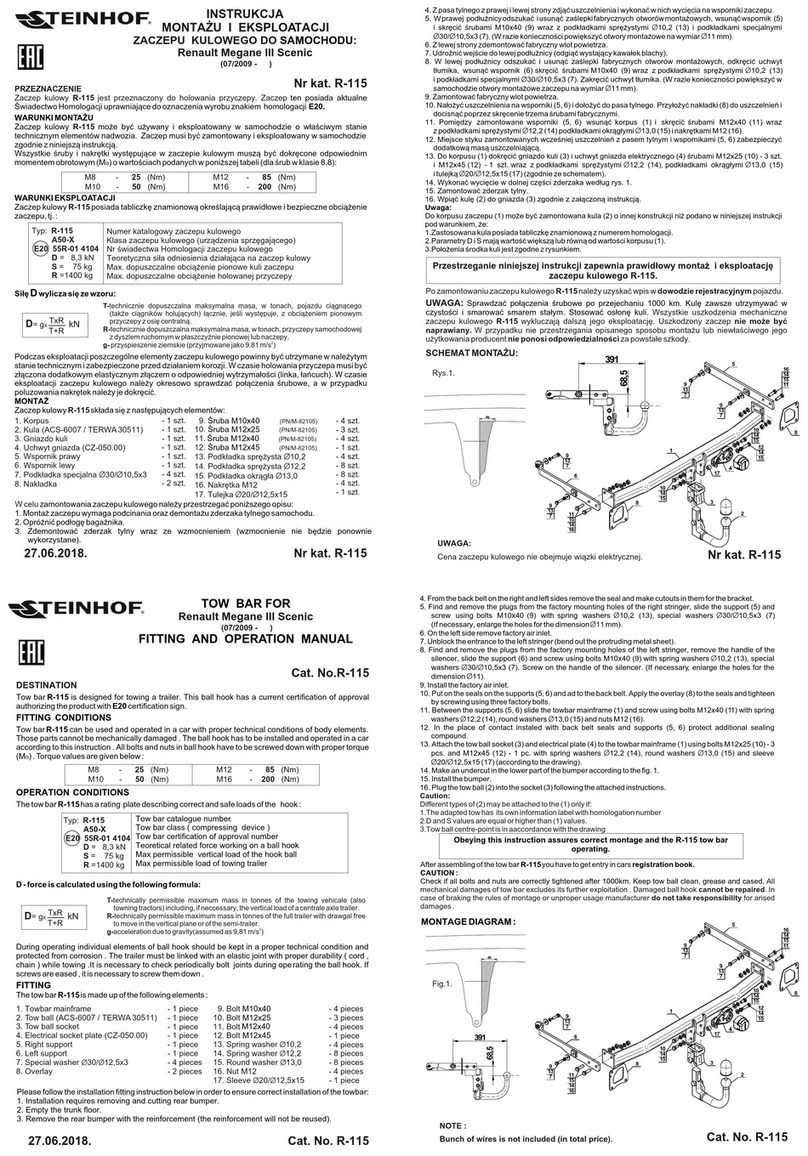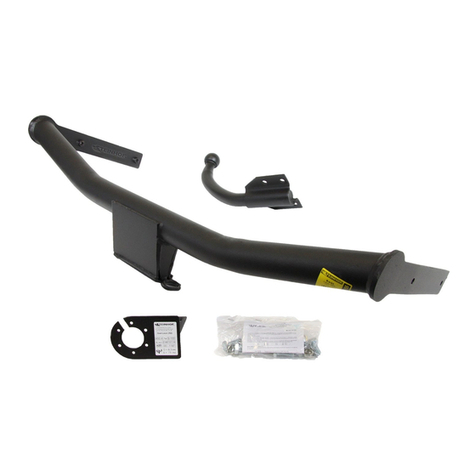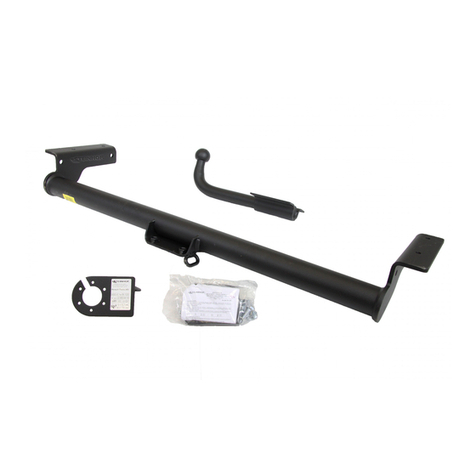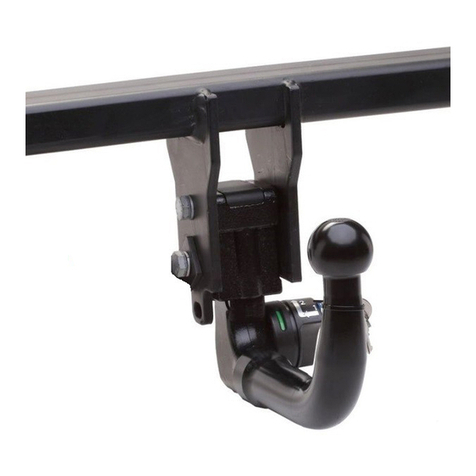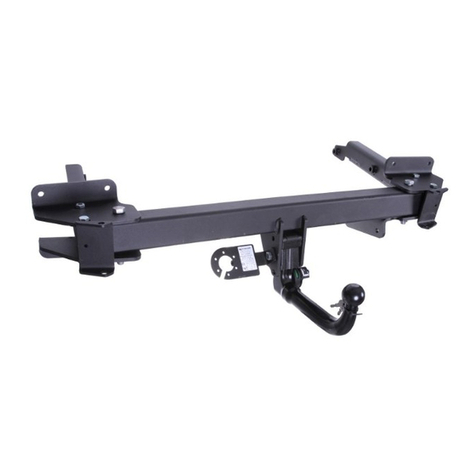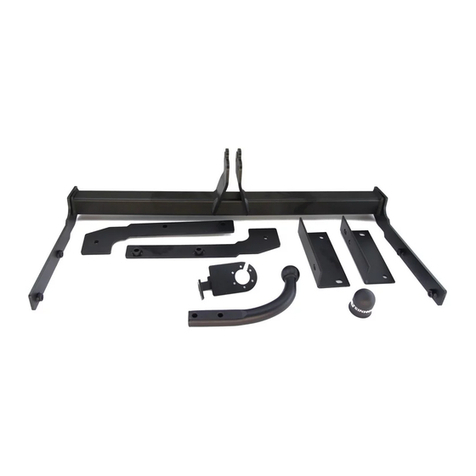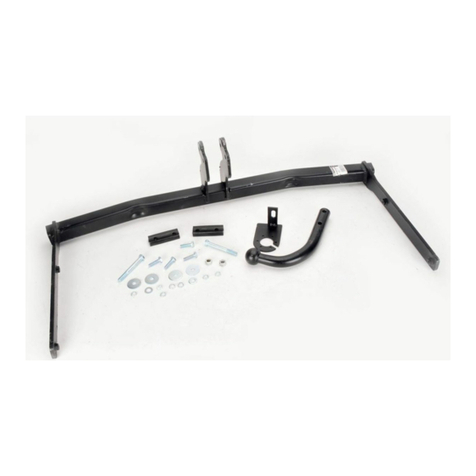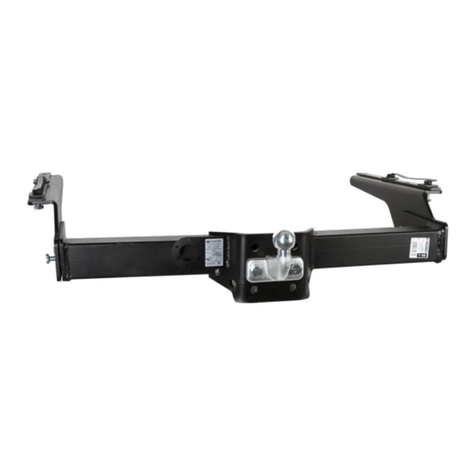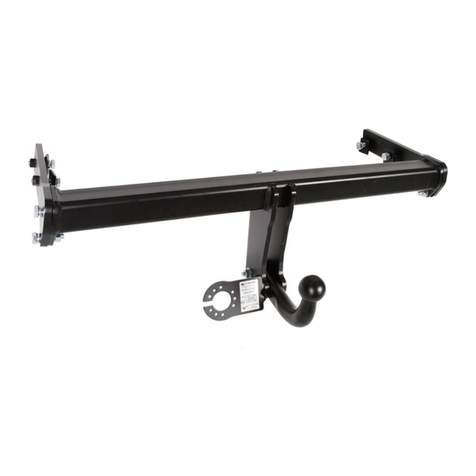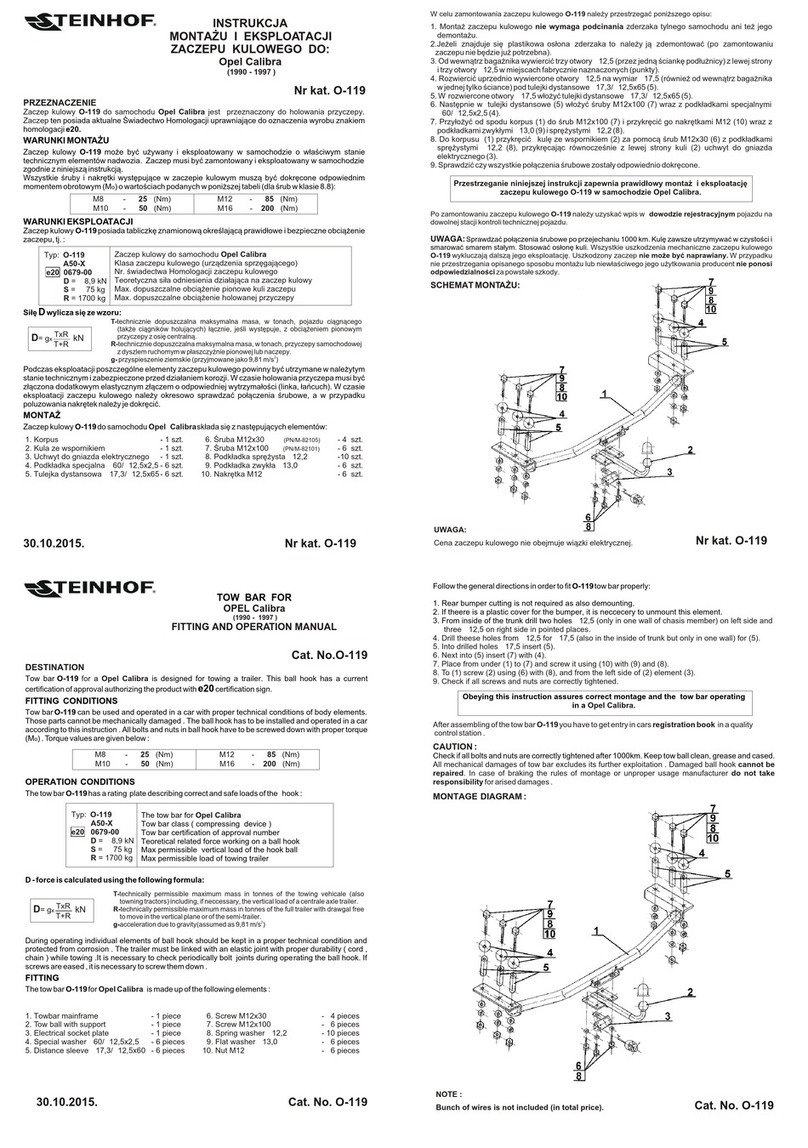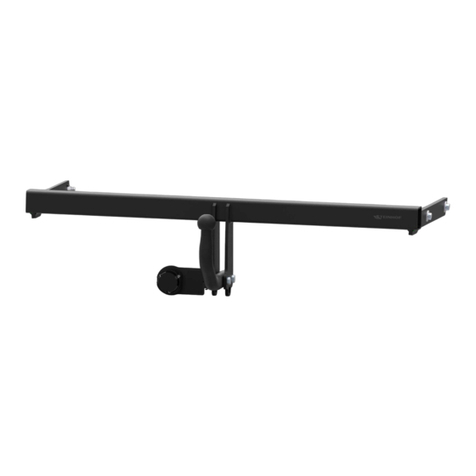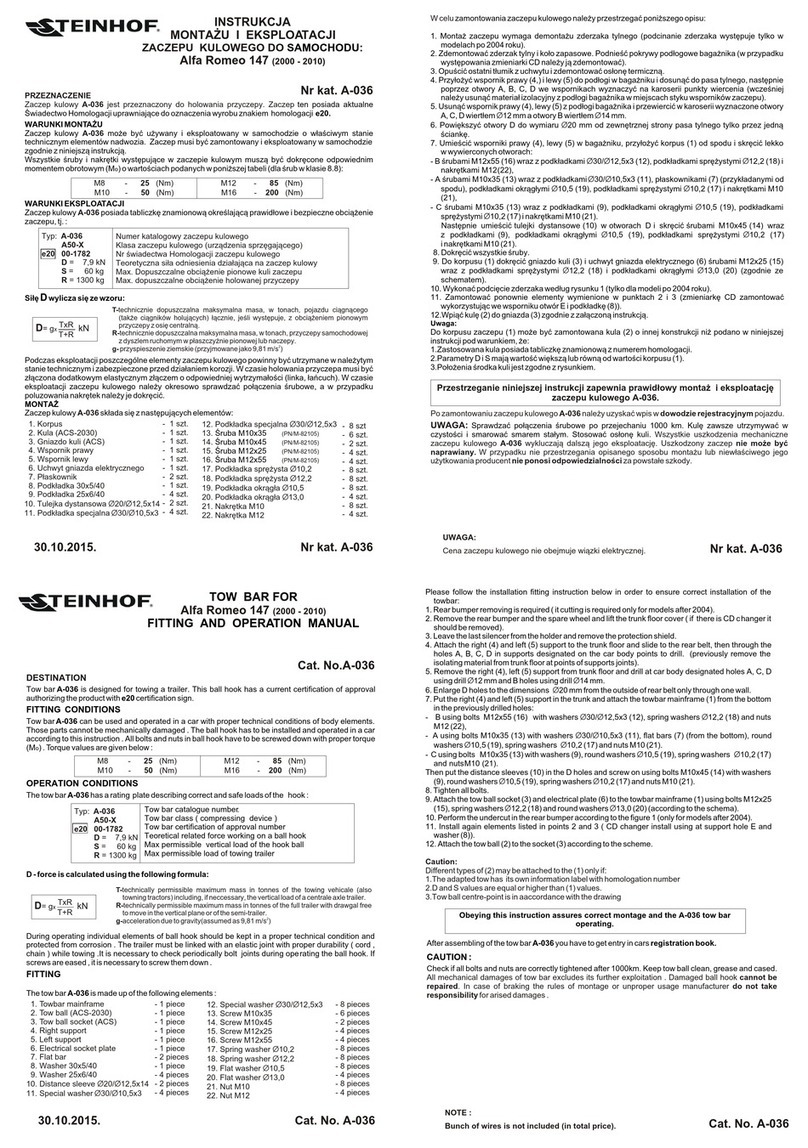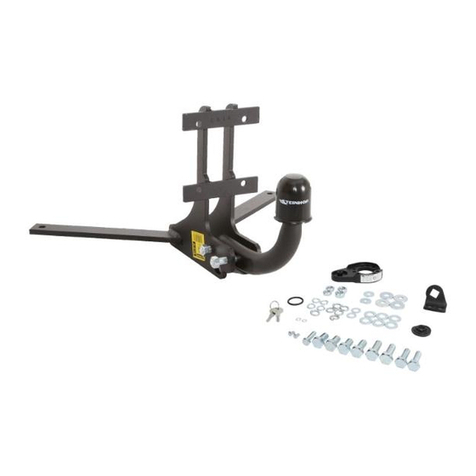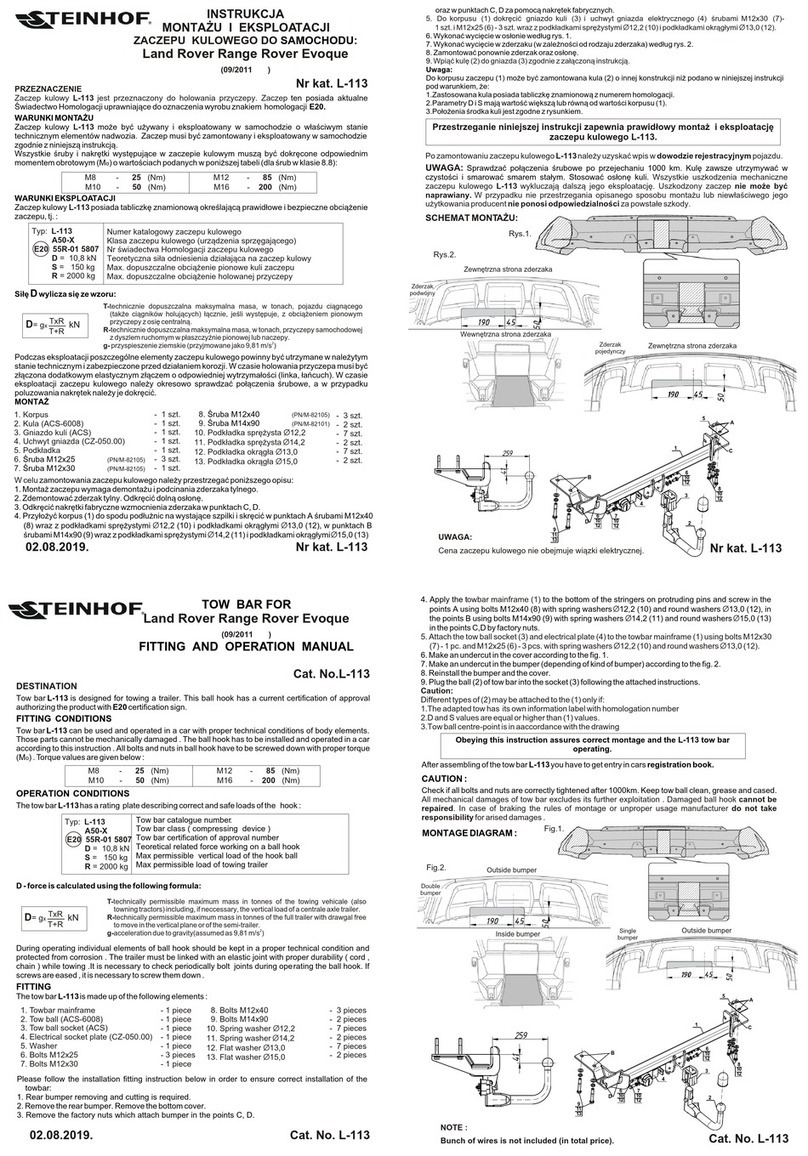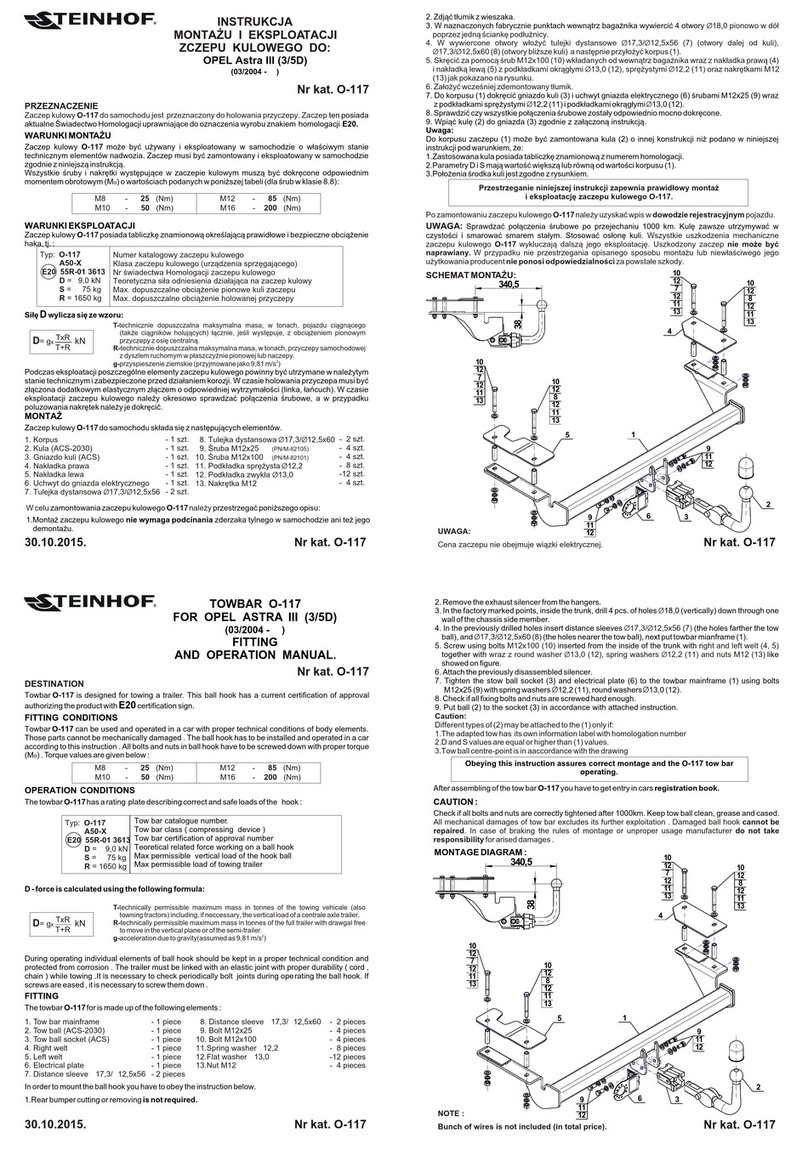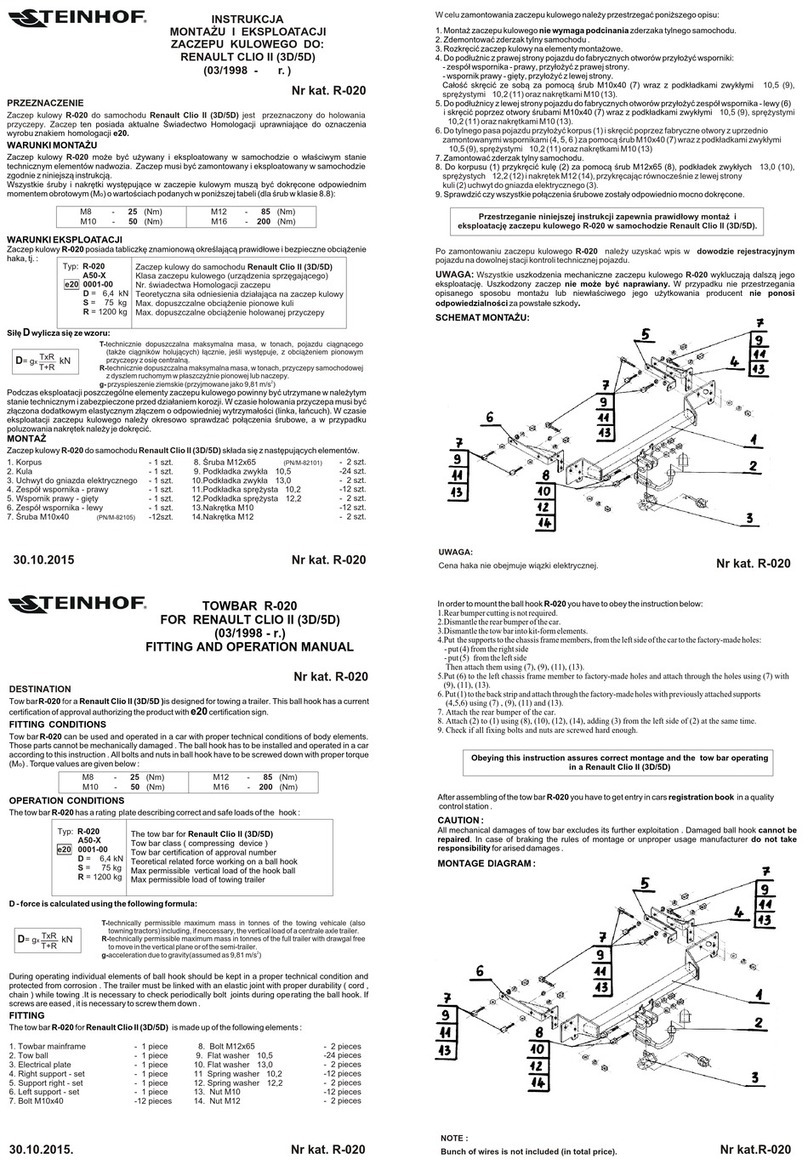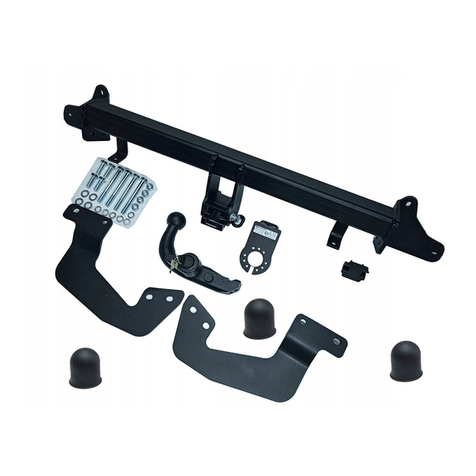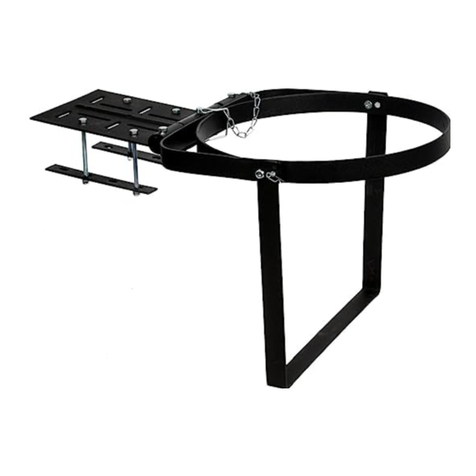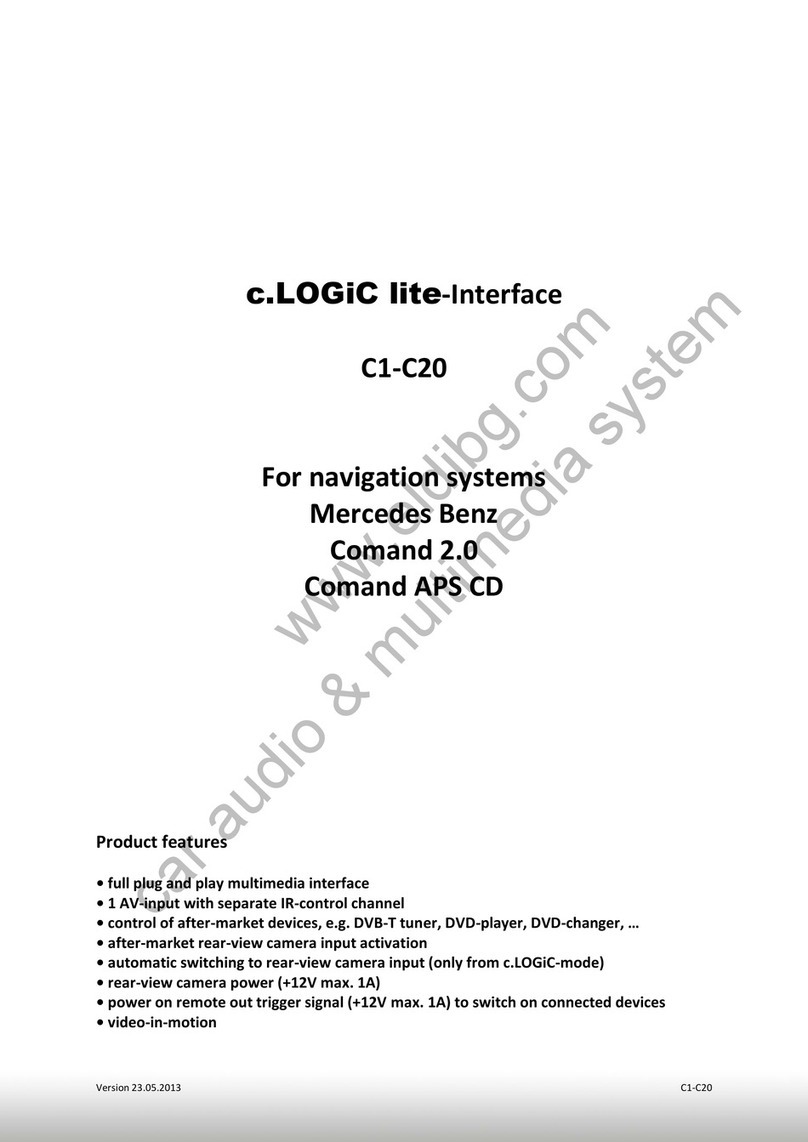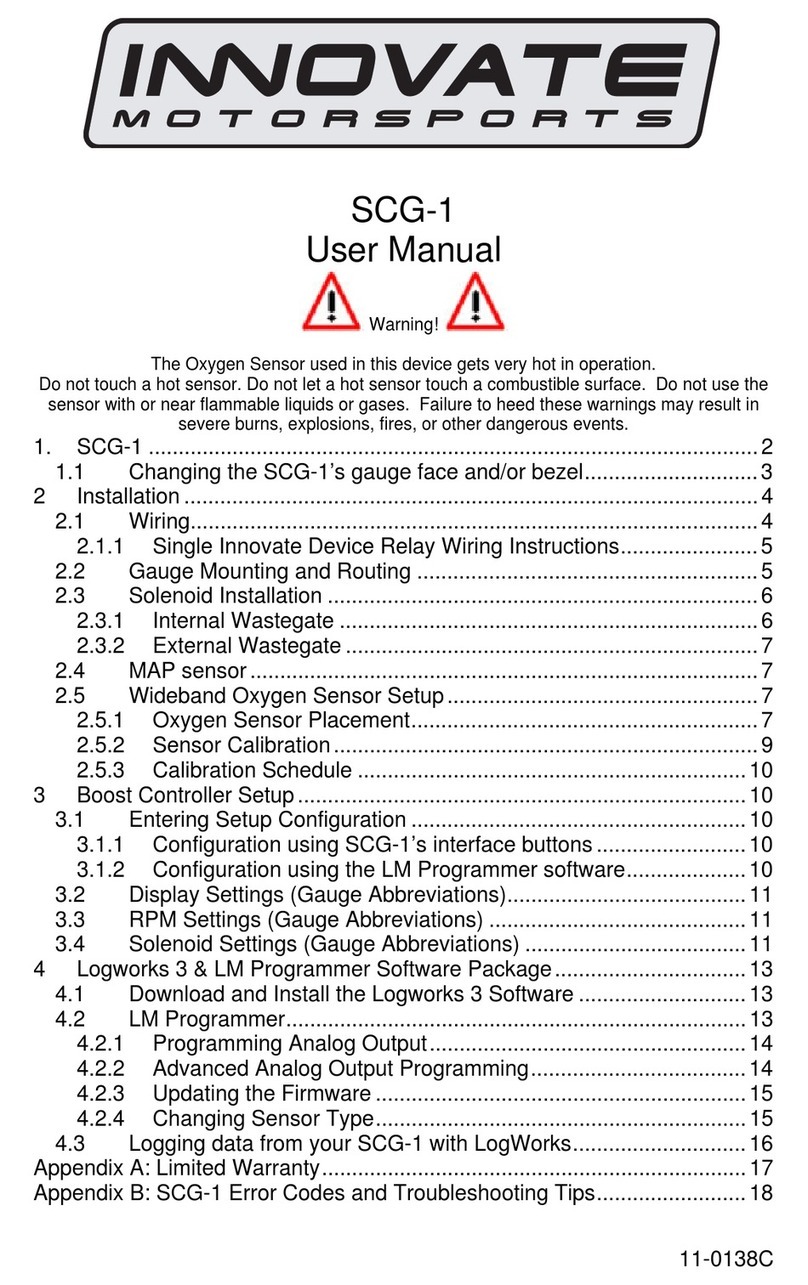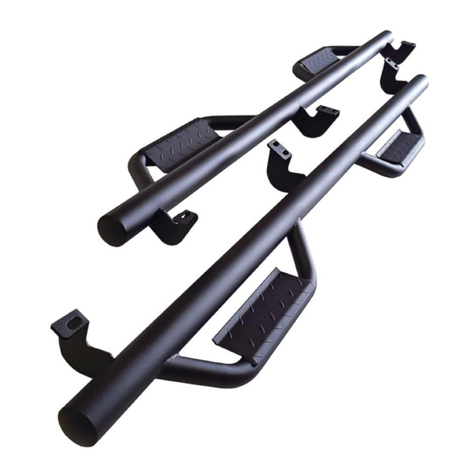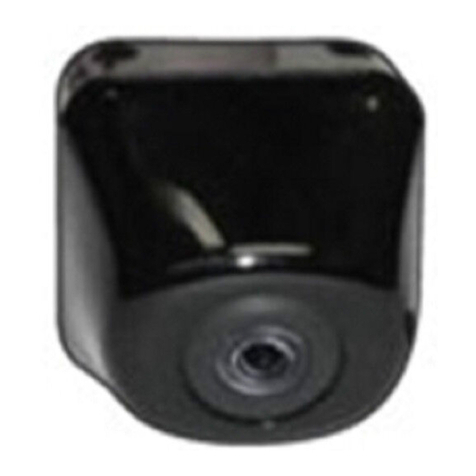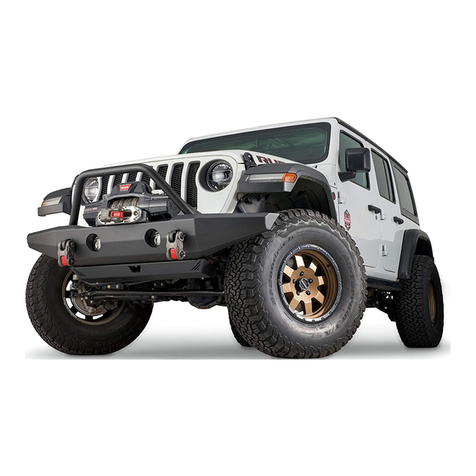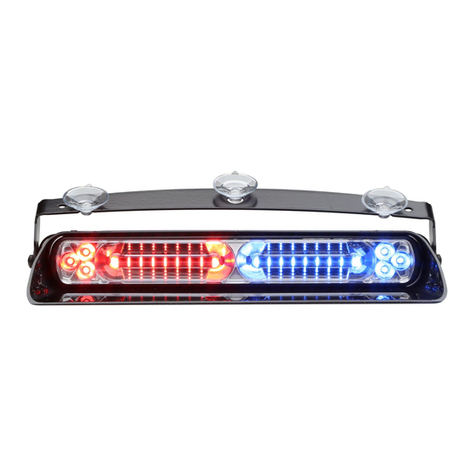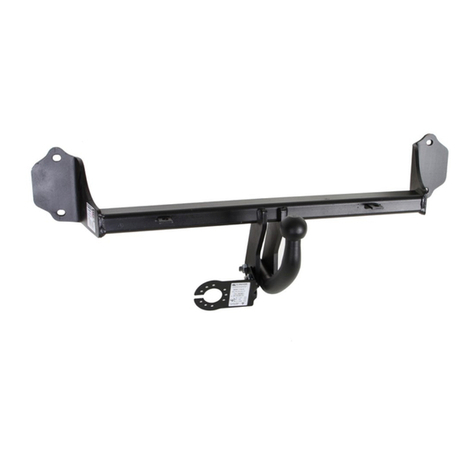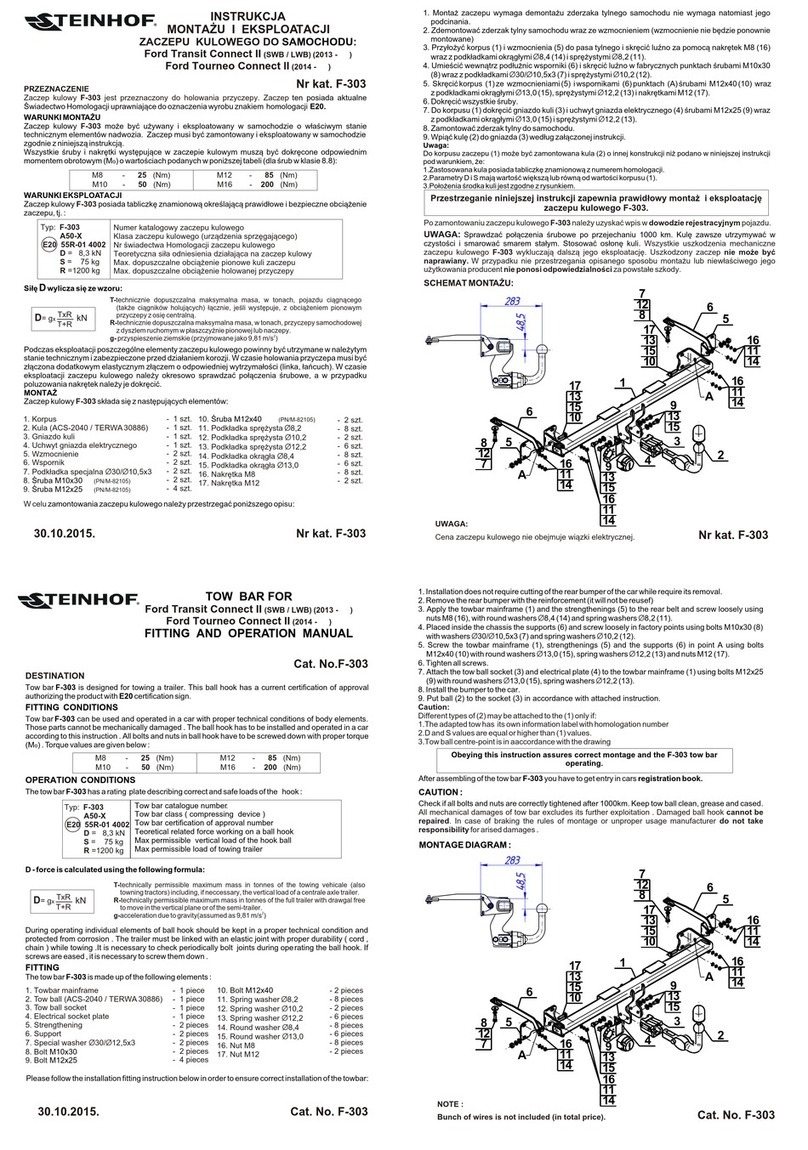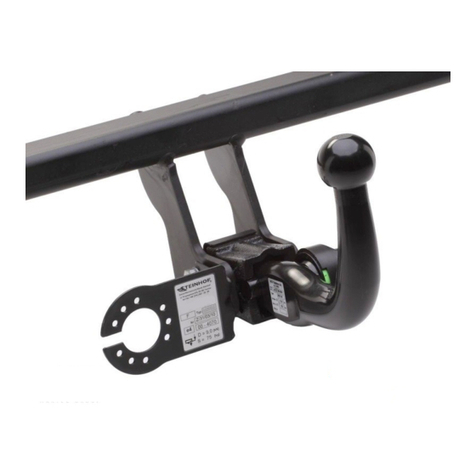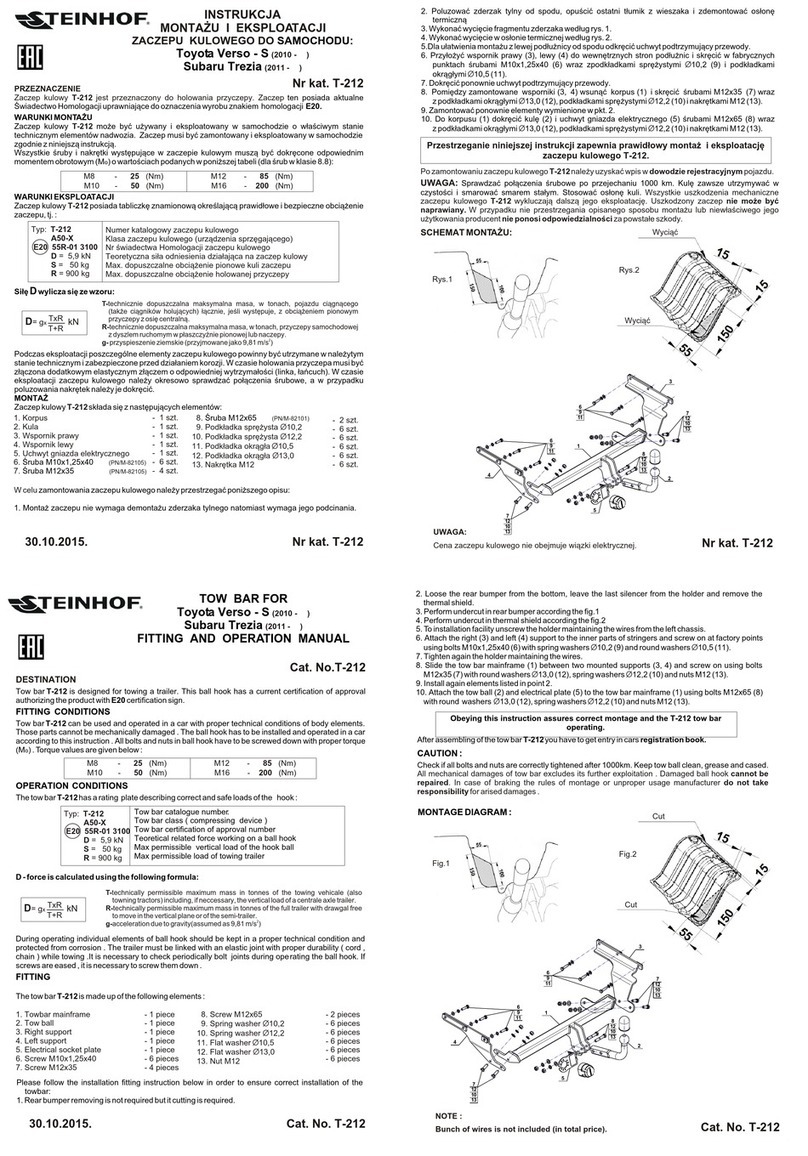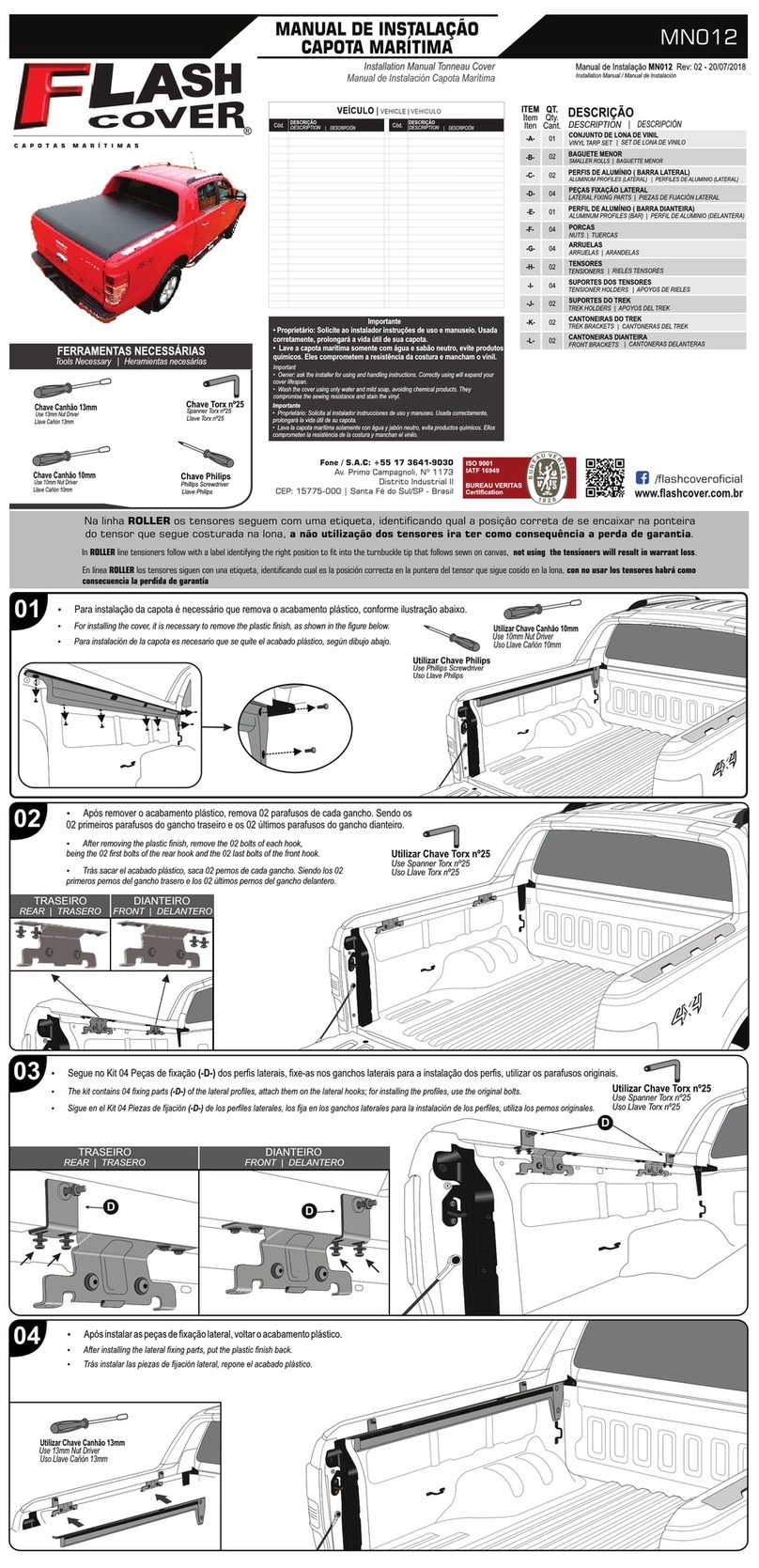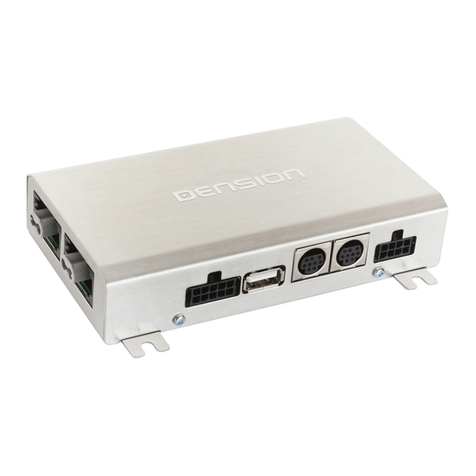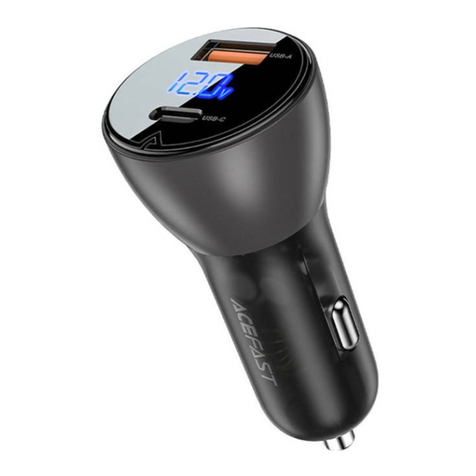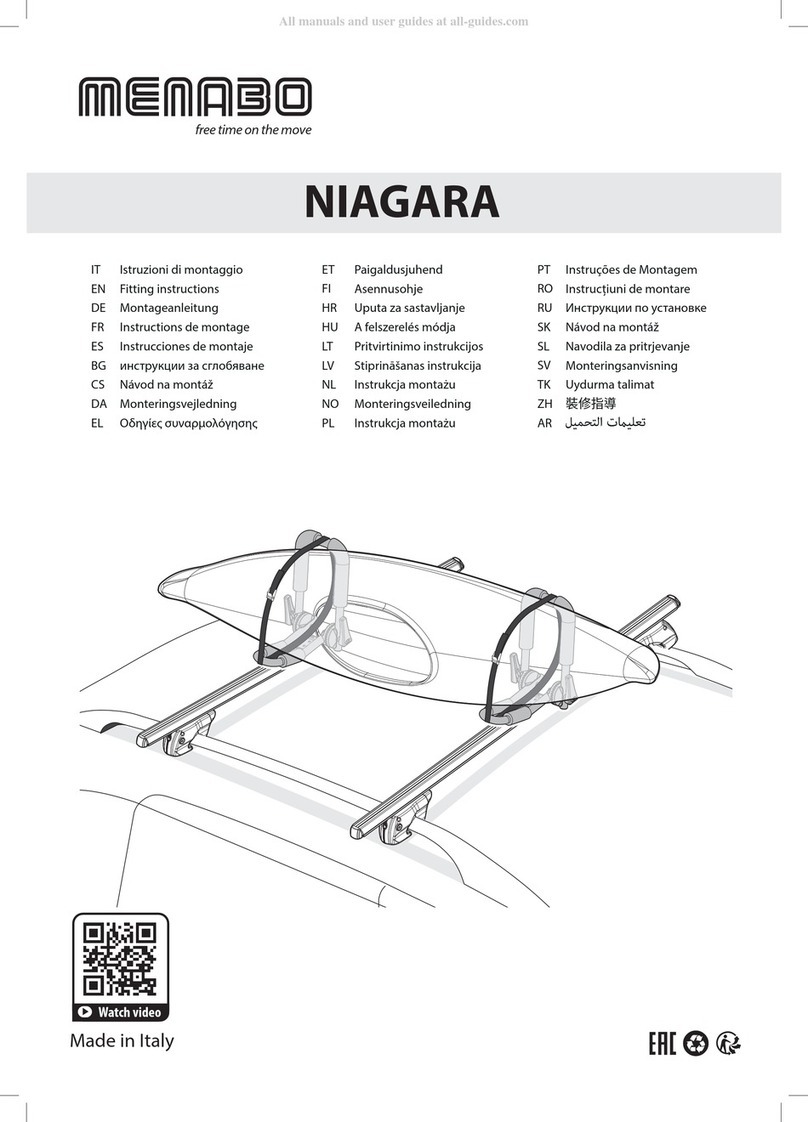
INSTRUKCJA
MONTA¯U I EKSPLOATACJI
ZACZEPU KULOWEGO DO :
Renault Megane Scenic (oprócz 4x4)
SAMOCHODU
(1996-06/2003)
Nr kat. R-101
PRZEZNACZENIE
Zaczep kulowy R-101 jest przeznaczony do holowania przyczepy. Zaczep
R-101
R-101
ten posiada aktualne
Œwiadectwo Homologacji uprawniaj¹ce do oznaczenia wyrobu znakiem homologacji e4.
WARUNKI MONTA¯U
Zaczep kulowy mo¿e byæ u¿ywany i eksploatowany w samochodzie o w³aœciwym stanie
technicznym elementów nadwozia. Zaczep musi byæ zamontowany i eksploatowany w samochodzie
zgodnie z niniejsz¹ instrukcj¹.
Wszystkie œruby i nakrêtki wystêpuj¹ce w zaczepie kulowym musz¹ byæ dokrêcone odpowiednim
momentem obrotowym (Mo) o wartoœciach podanych w poni¿szej tabeli (dla œrub w klasie 8.8):
WARUNKI EKSPLOATACJI
Zaczep kulowy posiada tabliczkê znamionow¹ okreœlaj¹c¹ prawid³owe i bezpieczne obci¹¿enie
zaczepu, tj. :
Si³ê Dwylicza siê ze wzoru:
Podczas eksploatacji poszczególne elementy zaczepu kulowego powinny byæ utrzymane w nale¿ytym
stanie technicznym i zabezpieczone przed dzia³aniem korozji. W czasie holowania przyczepa musi byæ
z³¹czona dodatkowym elastycznym z³¹czem o odpowiedniej wytrzyma³oœci (linka, ³añcuch). W czasie
eksploatacji zaczepu kulowego nale¿y okresowo sprawdzaæ po³¹czenia œrubowe, a w przypadku
poluzowania nakrêtek nale¿y je dokrêciæ.
MONTA¯
30.10.2015. Nr kat. R-101
M8 - 25 (Nm)
M10 - 50 (Nm)
M12 - 85 (Nm)
M16 - 200 (Nm)
Numer katalogowy zaczepu kulowego
Klasa zaczepu kulowego (urz¹dzenia sprzêgaj¹cego)
Nr œwiadectwa Homologacji zaczepu kulowego
Teoretyczna si³a odniesienia dzia³aj¹ca na zaczep kulowy
Max. dopuszczalne obci¹¿enie pionowe kuli zaczepu
Max. dopuszczalne obci¹¿enie holowanej przyczepy
Przestrzeganie niniejszej instrukcji zapewnia prawid³owy monta¿ i eksploatacjê
zaczepu kulowego R-101.
D= gx kN
TxR
T+R
T-technicznie dopuszczalna maksymalna masa, w tonach, pojazdu ci¹gn¹cego
(tak¿e ci¹gników holuj¹cych) ³¹cznie, jeœli wystêpuje, z obci¹¿eniem pionowym
przyczepy z osiê centraln¹.
R-technicznie dopuszczalna maksymalna masa, w tonach, przyczepy samochodowej
z dyszlem ruchomym w p³aszczyŸnie pionowej lub naczepy.
2
g- przyspieszenie ziemskie (przyjmowane jako 9,81 m/s )
W celu
ØØ Ø
ØØ ØØ Ø
ØØ
ØØ
ØØ Ø
ØØ Ø
ØØ
Ø
ØØ
zamontowania zaczepu kulowego nale¿y przestrzegaæ poni¿szego opisu:
1. Monta¿ zaczepu nie wymaga demonta¿u ani podcinania zderzaka tylnego.
2. Odszukaæ na pasie tylnym fabryczne otwory monta¿owe (w razie potrzeby usun¹æ masê uszczelniaj¹c¹).
3. Umieœciæ w fabrycznych otworach nakrêtki klatkowe okr¹g³e M8 (25) dla wersji samochodu z otworami
wed³ug rys. A lub nakrêtki klatkowe prostok¹tne (26) dla wersji samochodu z otworami wed³ug rys. B.
4. Przy³o¿yæ do pasa tylnego wzmocnienia prawe (7), lewe (8) i skrêciæ œrubami M8x25 (14) wraz
z podk³adkami 24/ 8,5x2,5 (10), podk³adkami sprê¿ystymi 8,2 (22) oraz skrêciæ œrubami M10x35 (15)
wraz z podk³adkami 30/ 10,5x3 (11), podk³adkami 40/ 10,5x3 (13), podk³adkami sprê¿ystymi 10,2
(23) i nakrêtkami M10 (27).
5. Umieœciæ w pod³u¿nicach (od strony zewnêtrznej) w otworach fabrycznych tulejki dystansowe
17,3/ 12,5x55 (9). Nastêpnie przy³o¿yæ wsporniki (5, 6) do wewnêtrznych stron pod³u¿nic i skrêciæ lekko
w fabrycznych punktach œrubami M10x100 (17) i M10x120 (18) wraz z podk³adkami 30/ 10,5x3 (11),
podk³adkami 40/ 10,5x3 (13), podk³adkami 10,2 (23) i nakrêtkami M10 (27) (zgodnie ze schematem).
6. Skrêciæ korpus (1) ze wspornikiem prawym (5), lewym (6) œrubami M12x40 (20) wraz z podk³adkami
30/ 12,5x3 (12), podk³adkami sprê¿ystymi 12,2 (24) i nakrêtkami M12 (28) oraz skrêciæ ze
wzmocnieniem prawym (7), lewym (8) œrubami M10x40 (16) wraz z podk³adkami 30/ 10,5x3 (11),
podk³adkami sprê¿ystymi 10,2 (23) i nakrêtkami M10 (27).
7. Dokrêciæ wszystkie œruby.
8. Do korpusu (1) dokrêciæ gniazdo kuli (3) i uchwyt gniazda elektrycznego (4) œrubami M12x25 (19) wraz
z podk³adkami sprê¿ystymi 12,2 (24), podk³adkami okr¹g³ymi 13,0 (21).
9. Wpi¹æ kulê (2) do gniazda (3) zgodnie z za³¹czon¹ instrukcj¹.
Uwaga:
Do korpusu zaczepu (1) mo¿e byæ zamontowana kula (2) o innej konstrukcji ni¿ podano w niniejszej instrukcji
pod warunkiem, ¿e:
1.Zastosowana kula posiada tabliczkê znamionow¹ z numerem homologacji.
2.Parametry D i S maj¹ wartoœæ wiêksz¹ lub równ¹ od wartoœci korpusu (1).
3.Po³o¿enia œrodka kuli jest zgodne z rysunkiem.
1. Korpus
2. Kula (ACS-2011)
3. Gniazdo kuli (ACS)
4. Uchwyt gniazda elektrycznego
5. Wspornik prawy
6. Wspornik lewy
7. Wzmocnienie prawe
8. Wzmocnienie lewe
9. Tulejka dystansowa Ø17,3/Ø12,5x55
10. Podk³adka specjalna Ø24/Ø8,5x2,5
11. Podk³adka specjalna Ø30/Ø10,5x3
12. Podk³adka specjalna Ø30/Ø12,5x3
13. Podk³adka specjalna Ø40/Ø10,5x3
14. (PN/M-82105)Œruba M8x25
- 1 szt.
- 1 szt.
- 1 szt.
- 1 szt.
- 1 szt.
- 1 szt.
- 1 szt.
- 1 szt.
- 2 szt.
- 2 szt.
-11 szt.
- 6 szt.
- 4 szt.
- 2 szt.
15. (PN/M-82105)
16. (PN/M-82105)
17. (PN/M-82101)
18. (PN/M-82101)
19. (PN/M-82105)
20. (PN/M-82105)
21. Podk³adka okr¹g³a Ø13,0
22. Podk³adka sprê¿ysta Ø8,2
23. Podk³adka sprê¿ysta Ø10,2
24. Podk³adka sprê¿ysta Ø12,2
25. Nakrêtka klatkowa M8 (CH-004.01)
26. Nakrêtka klatkowa M8 (CH-005.01)
27. Nakrêtka M10
28. Nakrêtka M12
Œruba M10x35
Œruba M10x40
Œruba M10x100
Œruba M10x120
Œruba M12x25
Œruba M12x40
- 2 szt.
- 4 szt.
- 1 szt.
- 1 szt.
- 4 szt.
- 4 szt.
- 4 szt.
- 2 szt.
- 8 szt.
- 8 szt.
- 2 szt.
- 2 szt.
- 7 szt.
- 2 szt.
Typ: R-101
F
e4 00-4443
D = 8,0 kN
S = 75 kg
R = 1400 kg
UWAGA:
Cena zaczepu kulowego nie obejmuje wi¹zki elektrycznej. Nr kat. R-101
2
3
4
6
20
12
12
24
28 20
24
12 16
11
11
23
27
17
23
13
9
20
24
12
20
12
12
24
28
16
11
11
23
27
19
24
21
14
22
10
25
15
11
13
23
27
25
26
7
14
22
10
15
11
13
23
27
8
5
19
24
21
1
18
11
9
13
23
27
26
Po zamontowaniu zaczepu kulowego R-101 nale¿y uzyskaæ wpis w dowodzie rejestracyjnym pojazdu.
UWAGA:
Wszystkie uszkodzenia mechaniczne zaczepu kulowego
R-101 wykluczaj¹ dalsz¹ jego eksploatacjê. Uszkodzony zaczep nie mo¿e byæ naprawiany.W przypadku nie
przestrzegania opisanego sposobu monta¿u lub niew³aœciwego jego u¿ytkowania producent nie ponosi
odpowiedzialnoœci za powsta³e szkody.
SCHEMAT MONTA¯U:
Sprawdzaæ po³¹czenia œrubowe po przejechaniu 1000 km. Kulê zawsze utrzymywaæ w czystoœci i
smarowaæ smarem sta³ym. Stosowaæ os³onê kuli.
DESTINATION
Tow bar R-101 is designed for towing a trailer. This ball hook has a current certification of approval
authorizing the product with e4 certification sign.
FITTING CONDITIONS
Tow bar R-101 can be used and operated in a car with proper technical conditions of body elements.
Those parts cannot be mechanically damaged . The ball hook has to be installed and operated in a car
according to this instruction . All bolts and nuts in ball hook have to be screwed down with proper torque
(Mo) . Torque values are given below :
OPERATION CONDITIONS
The tow bar R-101 has a rating plate describing correct and safe loads of the hook :
D - force is calculated using the following formula:
During operating individual elements of ball hook should be kept in a proper technical condition and
protected from corrosion . The trailer must be linked with an elastic joint with proper durability ( cord ,
chain ) while towing .It is necessary to check periodically bolt joints during operating the ball hook. If
screws are eased , it is necessary to screw them down .
FITTING
The tow bar R-101 is made up of the following elements :
Cat. No.R-101
30.10.2015. Cat. No. R-101
M8 - 25 (Nm)
M10 - 50 (Nm)
M12 - 85 (Nm)
M16 - 200 (Nm)
Tow bar catalogue number.
Tow bar class ( compressing device )
Tow bar certification of approval number
Teoretical related force working on a ball hook
Max permissible vertical load of the hook ball
Max permissible load of towing trailer
D= gx kN
TxR
T+R
T-technically permissible maximum mass in tonnes of the towing vehicale (also
towning tractors) including, if neccessary, the vertical load of a centrale axle trailer.
R-technically permissible maximum mass in tonnes of the full trailer with drawgal free
to move in the vertical plane or of the semi-trailer.
2
g-acceleration due to gravity(assumed as 9,81 m/s )
Obeying this instruction assures correct montage and the R-101 tow bar
operating.
Please follow the installation fitting instruction below in order to ensure correct installation of the towbar:
1. Rear bumper removing and cutting is not required.
2. Locate the factory rear belt holes (if necessary, remove the sealing compound).
3. Place in a factory holes the round cage nuts M8 (25) for the version of the car with holes as shown on the
drawing A or the rectangular cage nuts (26) for the version of the car with holes as shown on the drawing
B.
4. Put to the rear belt right (7) and also left strengthening (8) and screw using bolts M8x25 (14) together with
washers 24/ 8,5x2,5 (10) and spring washers 8,2 (22) and next screw using bolts M10x35 (15)
together with washers 30/ 10,5x3 (11), washers 40/ 10,5x3 (13), spring washers 10,2 (23) and
nuts M10 (27).
5. Place in the factory holes of stringers (from the outer side) the distance sleeves 17,3/ 12,5x55 (9), then
apply the supports (5 and 6) to the internal sides of the stringers and tighten slightly in the factory points
using bolts M10x100 (17) and M10x120 (18) together with washers 30/ 10,5x3 (11), washers
40/ 10,5x3 (13), washers 10,2 (23) and nuts M10 (27) (according to the schema).
6. Tighten the corps (1) with the right (5) and left support (6) using bolts M12x40 (20) together with washers
30/ 12,5x3 (12), spring washers 12,2 (24) and nuts M12 (28) and next tighten with right (7) and left
strengthening (8) using bolts M10x40 (16) together with washers 30/ 10,5x3 (11), spring washers
10,2 (23) and nuts M10 (27).
7. Screw all bolts.
8. Tighten tow ball socket (3) and electrical plate (4) to the corps (1) using bolts M12x25 (19) together with
the flat washers 13,0 (21), spring washers 12,2 (24).
9. Plug the tow ball (2) into the socket (3) following the attached instructions.
ØØ Ø
ØØ ØØ Ø
ØØ
ØØ
ØØ Ø
ØØ Ø
ØØ
Ø
ØØ
Caution:
Different types of (2) may be attached to the (1) only if:
1.The adapted tow has its own information label with homologation number
2.D and S values are equal or higher than (1) values.
3.Tow ball centre-point is in aaccordance with the drawing
TOW BAR FOR
FITTING AND OPERATION MANUAL
Renault Megane Scenic (except 4x4)
(1996-06/2003)
Typ: R-101
F
e4 00-4443
D = 8,0 kN
S = 75 kg
R = 1400 kg
1. Tow bar mainframe
2. Tow ball (ACS-2011)
3. Tow ball socket (ACS)
4. Electrical socket plate
5. Right support
6. Left support
7. Right strengthening
8. Left strengthening
9. Distance sleave Ø17,3/Ø12,5x55
10. Special washer Ø24/Ø8,5x2,5
11. Special washer Ø30/Ø10,5x3
12. Special washer Ø30/Ø12,5x3
13. Special washer Ø40/Ø10,5x3
14. Bolt
M8x25
- 1 piece
- 1 piece
- 1 piece
- 1 piece
- 1 piece
- 1 piece
- 1 piece
- 1 piece
- 2 pieces
- 2 pieces
-11 pieces
- 6 pieces
- 4 pieces
- 2 pieces
15. Bolt
16. Bolt
17. Bolt
18. Bolt
19. Bolt
20. Bolt
21. Flat washer Ø13,0
22. Spring washer Ø8,2
23. Spring washer Ø10,2
24. Spring washer Ø12,2
25. Cage Nut M8 (CH-004.01)
26. Cage Nut M8 (CH-005.01)
27. Nut M10
28. Nut M12
M10x35
M10x40
M10x100
M10x120
M12x25
M12x40
- 2 pieces
- 4 pieces
- 1 piece
- 1 pieces
- 4 pieces
- 4 pieces
- 4 pieces
- 2 pieces
- 8 pieces
- 8 pieces
- 2 pieces
- 2 pieces
- 7 pieces
- 2 pieces
MONTAGE DIAGRAM :
NOTE :
Bunch of wires is not included (in total price). Cat. No. R-101
2
3
4
6
20
12
12
24
28 20
24
12 16
11
11
23
27
17
23
13
9
20
24
12
20
12
12
24
28
16
11
11
23
27
19
24
21
14
22
10
25
15
11
13
23
27
25
26
7
14
22
10
15
11
13
23
27
8
5
19
24
21
1
18
11
9
13
23
27
26
After assembling of the tow bar R-101 you have to get entry in cars registration book.
CAUTION :
Check if all bolts and nuts are correctly tightened after 1000km. Keep tow ball clean, grease and cased. All
mechanical damages of tow bar excludes its further exploitation . Damaged ball hook cannot be repaired. In
case of braking the rules of montage or unproper usage manufacturer do not take responsibility for arised
damages .



